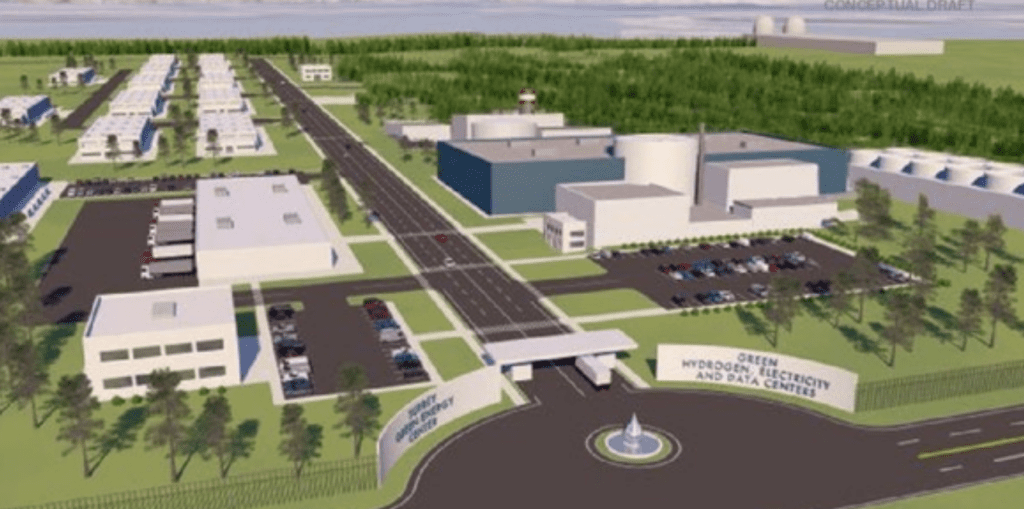Hydrogen Production, SMRs Touted for Virginia Data Center Hub
Two companies supporting different technologies in the energy sector have formed a joint venture to develop an industrial park in Virginia that could feature data centers powered by hydrogen gas generators and small modular reactors (SMRs).
Green Energy Partners (GEP), a Pennsylvania-based group better known for its development of solar power, and IP3 International—a nuclear power developer based in Virginia—earlier this year announced plans for a data center hub sited on 641 acres adjacent to Dominion’s 1.6-GW Surry nuclear power plant in southeastern Virginia.
The industrial park project, called the Surry Green Energy Center (SGEC), would feature a hub powered by on-site renewable energy and SMRs. Officials familiar with the project said it could include four to six SMRs that would provide energy for 20 to 30 data centers, along with generating hydrogen fuel and providing backup power for the Virginia grid.
“We’re going to create a data center park first, and that data center park will get power from the local utility, and we will build lots, and we will sell those lots to data center providers,” said IP3 CEO Michael Hewitt in comments to UK-based The Register, an online news source, published August 17. IP3 supports the development of nuclear power plants in the U.S. and Europe. Hewitt said, “We see that as a very lucrative investment, particularly when you look at the going rate for a data center lot in, say, Northern Virginia.”
Two-Phase Project
The project would be built in two phases, with the SMRs expected to be deployed in the second phase of the development. Officials said the first phase of data centers would create a customer base that could support private investment for the development of the SMRs.
Officials in Virginia have said the state’s data centers process more than 70% of the world’s Internet data. Those facilities also use about 25% of the state’s power production.

Hewitt in a statement about the SGEC project said, “The Commonwealth of Virginia has developed a purposeful plan for their energy future. They are ready to harness the smart energy transition to create jobs for Americans and set an example for developing clean industrial zones. Infrastructure investment needs to be radically reoriented. The combined expertise of GEP and IP3 will access private capital markets to help Virginia’s energy sector become a model for an era of American energy sovereignty.”
Mark Andrews, CEO of GEP, in a statement said, “For nearly 50 years, we have delivered positive growth for Virginia. Today, we see a clear path to clean power that reinforces America’s national security and supports a carbon-free future. GEP and IP3 offer a powerful partnership to pioneer an America-first solution for low-carbon energy security.”
Nuclear Power for Distributed Energy
Other groups in the distributed energy space have talked about using nuclear energy—specifically from SMRs—to power industrial complexes, including data centers, which often use massive amounts of energy. Some companies, such as Microsoft, have talked about nuclear power while employing other technologies in the interim.
The topic of on-site power for industrial parks and data centers was discussed in various sessions at the recent Experience POWER Week, sponsored by POWER, which ran from Aug. 14-17 in Savannah, Georgia. That event co-located three events, including the Distributed Energy Conference, HydrogeNext, and Electric POWER Insights, each of which had discussions about nuclear power as well as providing information about markets for hydrogen fuel.
“There are a number of technologies that are in development around the SMR space, and light water reactor space, and in what they call the advanced modular space,” said Hewitt in his comments to The Register.
Hewitt said that GEP and IP3 expect the industrial park would need four to six SMRs, each with about 250 MW of generation capacity. Hewitt said the exact generation capacity required would depend on what type of nuclear technology is deployed. He noted the U.S. Nuclear Regulatory Commission would need to approve the technology, but he expects the SGEC could be running on nuclear power within a decade.
The companies said they plan to use the thermal energy generated by the SMRs to support the electrolysis of water into clean hydrogen, which could be used to fuel backup generators that would support the site. Hydrogen, which can be burned in engines that also run on natural gas, is being tested as an alternative to diesel fuel in backup generators. The fuel also could support other projects in Virginia using hydrogen fuel.
Hewitt said the Surry project’s location next to the existing nuclear power plant along the James River would be “ideal for the logistics of hydrogen shipping and distribution.” He said that even if the nuclear power component of the project is not realized, “we still have a data center site that makes money and has a great client.”
Microsoft Plan in Ireland
Microsoft in July of this year gained approval to use its own private natural gas-fired power plant to supply electricity for the company’s data centers at its Grange Castle Business Park in Dublin, Ireland. Grange Castle, which opened in 2009, was Microsoft’s first data center facility outside the U.S. Reports earlier this year said the Microsoft plant would have generation capacity of 170 MW from as many as 22 gas-fired generators; the project’s price tag has been estimated at more than $100 million.
Microsoft has said it would like to use fusion energy from Helion Energy, a fusion company based in Everett, Washington, near Microsoft’s headquarters in Redmond, to eventually power much of the company’s operations should fusion power become a commercial technology.
Amazon Web Services, or AWS, earlier this year said it planned to use natural gas fuel cells from Bloom Energy to provide power for some of the company’s data centers in Oregon. AWS earlier this year said it had invested $15 billion for a cloud cluster in Oregon to support the group’s cloud platform.
—Darrell Proctor is a senior associate editor for POWER (@POWERmagazine).